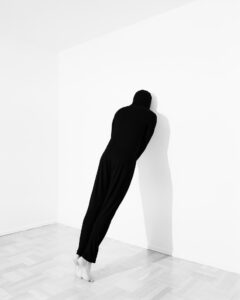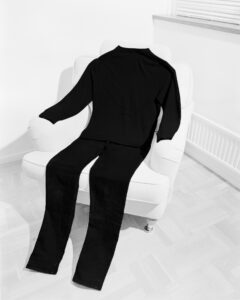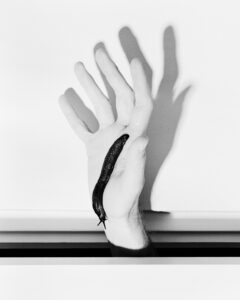



On Ambiguity in Photography
Whatever it is, it lingers
Picture: A figure, fully dressed in black, leaning forward, pressing their head against a white wall. Their body extends unnaturally, as if suspended between resistance and surrender. Bare feet contrast with the fabric that otherwise conceals every part of the body. The contrast is stark. Black against white. Form against emptiness. The facelessness erases identity, leaving only a silhouette of tension, of surrender, of something unresolved. The figure, faceless and anonymous, appears absorbed into the wall, yet their shadow lingers, as evidence of their existence. Are they resisting or yielding? Seeking solace or vanishing? There’s something unsettling here. Perhaps isolation, a quiet withdrawal into the walls. Or an absurd gesture, a silent defiance, a body becoming part of the space itself? Whatever it is, it lingers.
An ambiguous image resists singular meaning, shifting between interpretations with no fixed resolution. It is defined “as the ‘character of what is susceptible to several interpretations’: it can also be said to express the character of ‘what belongs to two categories’ and of ‘what lacks precision and disturbs’.”[1] Indeterminacy moves in a similar space—elusive, uncertain, always slipping from clear definition. It arises from ambiguity, incomplete information, or sheer unpredictability. Something remains open, unresolved, allowing multiple meanings to coexist, refusing to settle.[2]
The idea of “openness” in art emerged in the 20th century, as modernist and avant-garde movements sought to break away from conventional meaning and fixed interpretations. In The Open Work, Umberto Eco contrasts openness to “closed” works that allow only a single interpretation. Experiencing an open work is not passive. The audience brings their own emotions, thoughts, and cultural background, making each interpretation unique. Ambiguity, for Eco, is not a lack of clarity but a space of possibilities where multiple meanings can coexist. Open works thrive on this uncertainty, urging viewers to question, explore, and even challenge their own perceptions.[3]
—
Picture: A face meets the surface of a table, the chin rests precisely at the edge. The attached torso dissolves into black, leaving only the sharp contour of a face against an empty background. The shadow cast on the tabletop copies the face. Light clings to slicked-back hair. The figure does not resist, nor does it yield entirely. It remains suspended in a state of quiet endurance, as if waiting for something to pass. There is a undertone of punishment felt in the image. The forced posture suggests restraint, the weight of the head pressed down like a burden. It is not a violent act, but one of control. If it’s self-inflicted or imposed from the outside remains unknown.
From a philosophical perspective there are two primary ways to approach an image, two ways of seeing and making sense. The first is through semiology, where a photograph is understood as a system of signs, each element pointing to something beyond itself. In this way, images function like language, constructed through symbols, cultural references, and codes that shape meaning. The other way is phenomenological. Here, the focus is not on what the image represents, but on how it presents itself: how it appears, how it is experienced in the moment. Instead of breaking it down into signs and symbols, this approach focuses on the act of seeing, and the immediate response to what is there.
Photographs can contain certain elements or points that are not clear or fully defined and that can cause confusion or unease in the viewer. When we can see what a photograph shows but can’t fully understand its meaning, the image stays open to interpretation and remains unsettling. These kinds of photographs resist a clear and simple explanation. Because of this openness, they invite or propose a phenomenological reading. The points of indeterminateness act as a challenge for viewers. When the viewer can instantly understand why the photograph was taken, what it is meant to say, and what to think about it, they can easily move on from the picture and to the next one. But when the photograph’s unsettledness remains, it keeps the viewer’s attention and therefore makes them want to spend more time with it. [4]
—
Picture: A black outfit rests on a white armchair, carefully arranged as if worn by an invisible figure. The contours of the clothing fold over the chair, mimicking the way fabric would cover a sitting body, yet there is no body, no weight, no skin beneath. The contrast between the deep black of the clothing and the pale, almost clinical setting intensifies the strangeness of the scene. The chair, positioned in a well-lit, tidy space, appears domestic and familiar, yet something feels undeniably off. The image resists a singular interpretation. It could speak of absence: a person who was once there but is now gone, leaving only the trace of their form. It might suggest a disconnection between presence and identity, where clothing serves as a shell, a stand-in for the self, yet remains hollow without the body to inhabit it. The contrast between black and white heightens this sense of duality: presence and absence, materiality and void. There is also an unsettling playfulness at work—an illusion that initially amuses but quickly unsettles. The longer one looks, the more the image seems to ask: Is this a scene of departure or a lingering presence? Does the figure exist, or is it only imagined?
If an artist seeks to create an open work, one that invites engagement, that lingers in the mind, that resists easy conclusions, then the work itself must call for a phenomenological reading. This means leaving space, allowing room for uncertainty, for the viewer to step in and take part. But what does this space look like? What are these points of indeterminacy, and how can an artist shape them? Perhaps it is in what is withheld, in what remains unresolved. Perhaps it is in an image that unsettles and refuses to be pinned down. The challenge is not to dictate meaning, but to create the conditions where meaning can emerge. Looking at a body of work, two dimensions come into focus: content and form. Each plays a role in shaping meaning, and together they define how an artwork invites interpretation. There are no fixed boundaries to what an open work can explore: the very idea of openness resists limitation. Often, themes emerge where the line between fiction and reality is blurred. Psychological, existential, and emotional undercurrents surface, speaking both to the personal and the universal. In photography, images can be untethered from specific times, places, or events, creating space for the viewer’s own experiences to take over.
—
Picture: A pale, seemingly severed, hand reaches upward with fingers spread. Its skin appears unnaturally smooth, almost sculptural, drained of warmth and life. A dark slug moves across the palm, leaving a slimy, sticky trace. The slick, glistening body in contrast to the dry, rigid hand. Behind the hand, its deformed shadow stretches across the surface of the white wall. The shadow’s presence adds another layer of uncertainty. Does it mirror the hand’s gesture, or does it suggest an unseen force acting upon it? The image exists in a space of ambiguity. The hand could be offering, receiving, or resisting. The slug’s slow movement introduces an element of time, a creeping inevitability that the viewer can almost feel. There is an unease in the contrast between human and non-human, conscious control and instinctive movement. Is this an act of acceptance, revulsion, or surrender? The image invites interpretation but refuses a singular reading.

A photograph stays with you because it withholds. It does not explain, does not guide, but rather creates space for doubt, contradiction, or something unresolved. The moment meaning settles, the wonder dies. Ambiguity keeps it alive, shifting between possibilities. What remains is a question stretching beyond the frame.
_____________
Images: Andrej Lamut, Dividing by Zero, 2024
[1] Dario GAMBONI, Potential images, Ambiguity and Indeterminacy in Modern Art, London 2002, p 13
[2] Dario GAMBONI, Potential images, Ambiguity and Indeterminacy in Modern Art, London 2002, p 13
[3] Umberto ECO, The Open Work, Cambridge 1989
[4] Bettina LOCKEMANN, Thinking the Photobook. A Practical Guide, Berlin 2022, p 67